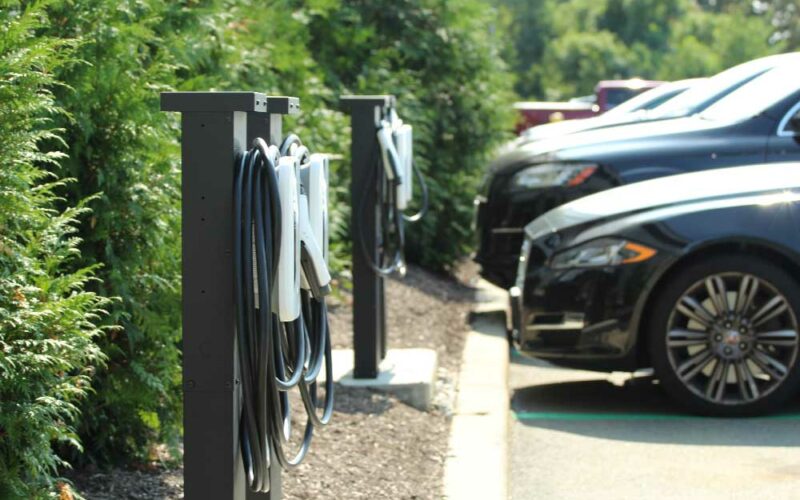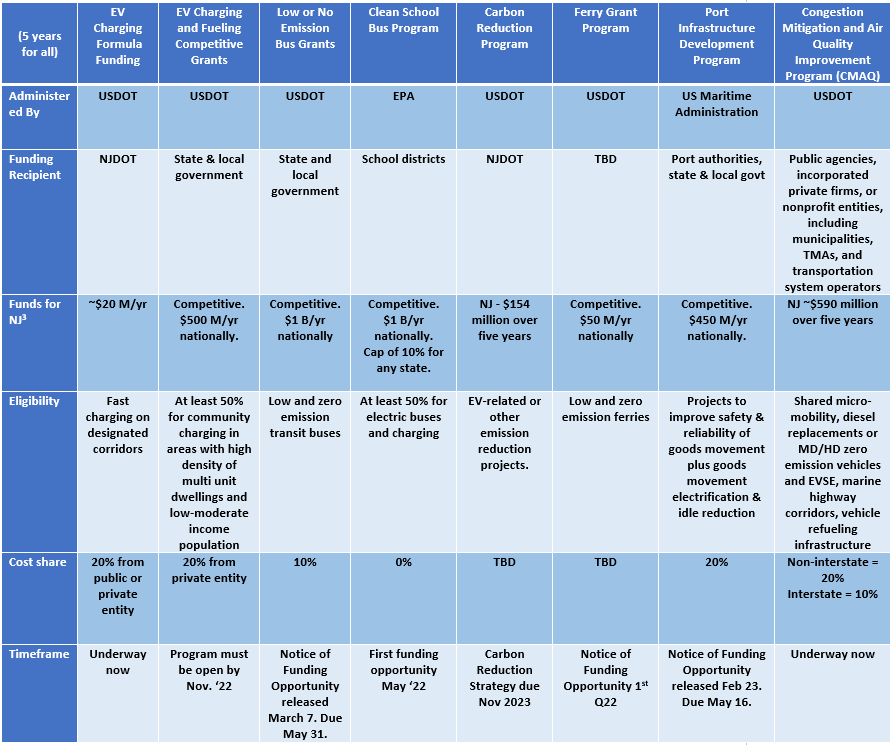

Infrastructure Investment and Jobs Act
Funding for Electric Vehicles/Equipment and EV Charging Stations1
The Bipartisan Infrastructure Law (BIL), enacted as the Infrastructure Investment and Jobs Act of 2021 (Public Law 117-58), continues the authorization of the national surface transportation legislation and appropriates $550 billion for new infrastructure investments. The BIL supports a variety of alternative fuel vehicle (AFV) and advanced vehicle technologies through grant programs, studies, technology standards, loans, research and development, fleet funding, and other measures. BIL includes provisions to increase investment in electric vehicle supply equipment (EVSE), alternative fuel infrastructure, electric vehicle (EV) batteries, electricity grid upgrades, and light-, medium-, and heavy-duty zero emission vehicles (ZEVs).2
1Refer to official website for details
2U.S. Department of Energy – Alternative Fuel Data Center. “Bipartisan Infrastructure Law (Infrastructure Investment and Jobs Act of 2021)” https://afdc.energy.gov/laws/infrastructure-investment-jobs-act
3FFIS’s IIJA State Allocations Spreadsheet
National Electric Vehicle Infrastructure (NEVI) Formula Program:
Funding Amount: $5 billion (Annually: $1 billion)
NJ Allocation: $104 million (Annually: ~$20.8 million)
Administering Agency: U.S. Department of Transportation (USDOT)
Timeframe: Underway Now
Provides funding to states to strategically deploy charging stations and to establish an interconnected network to facilitate data collection, access, and reliability. Funding is available for up to 80% of eligible project costs. Eligible costs include planning, acquisition, installation, and operation of charging infrastructure.
Charging stations must be located at intervals of no more than 50 miles along designated Federal Highway Administration Alternative Fuel Corridors. At a minimum, each corridor charging station must be capable of simultaneously charging four vehicles at 150kW each. Equipment must be non-proprietary, allow for open-access payment methods, be publicly available or available to authorized commercial motor vehicle operators from more than one company. If a state and USDOT determine that all Alternative Fuel Corridors in the state have been fully developed, then the state can propose alternative public locations and roads for charging station installation.
The Federal Highway Administration will distribute the funds in annual installments through FY 2026. To receive its $104 million in total funding, NJ must nominate corridors by May 13, 2022 and submit a plan to USDOT for review and public posting by August 1, 2022 describing how the state intends to distribute Program funds. On May 13, 2022, NJ submitted its corridor nominations.
On July 29, 2022, New Jersey submitted its National Electric Vehicle Infrastructure Deployment Plan.
On September 28, 2022, New Jersey’s amended Deployment Plan was approved. The Deployment Plan was amended after submission to withdraw the exception requests on p. 41 based on additional conversations with the Joint Office of Energy and Transportation.
NJ issued a Request for Information on December 5, 2022 and comments closed on January 13, 2023.
September 2024 – NJDOT NEVI Plan Update
Charging and Fueling Infrastructure Discretionary Grant Program:
Community Charging: $1.25 billion (Annually: $250 million)
Corridor Charging: $1.25 billion (Annually: $250 million)
NJ Allocation: N/A; this is a nationwide competitive solicitation. 10% cap per State.
Administering Agency: U.S. Department of Transportation (USDOT)
Timeframe: First funding opportunity awards announced January 2024
Competitive grant program to fill gaps in publicly accessible EV charging and hydrogen, propane, and natural gas fueling infrastructure along both designated alternative fuel corridors (50%) and in community locations (50%), such as a parking facilities, public schools, public parks, or along public roads. Funding of up to 80% of project costs will be available for both development phase planning activities and the acquisition and installation of charging or alternative fueling infrastructure, operating assistance, and acquisition and installation of traffic control devices. Five percent of the grant fund awarded may be used for educational and community engagement activities to develop and implement education programs through partnerships with schools, community organizations, and vehicle dealerships to support the use of zero-emission vehicles and associated infrastructure. USDOT must prioritize projects that expand access to charging and alternative fueling infrastructure within rural areas, low- and moderate-income neighborhoods, and communities with limited parking space or a high ratio of multi-unit dwellings to single-family homes. Eligible entities include states, metropolitan planning organizations, local governments, political subdivisions, and tribal governments.
New Jersey was awarded $10 million from the first round of funding.
Low or No Emission (Bus) Grants:
Funding: ~$5.6 billion
NJ Allocation: N/A; this is a nationwide competitive solicitation
Administering Agency: U.S. Department of Transportation (USDOT)
Timeframe: 2022 NOFO released March 7 – Due May 31, 2022
The Low or No Emission competitive program provides funding to state and local governmental authorities for the purchase or lease of zero-emission and low-emission transit buses as well as acquisition, construction, and leasing of required supporting facilities. Eligible applicants include direct or designated recipients of Federal Transit Administration grants; States; local governmental authorities; and Indian Tribes. Except for projects proposed by Indian Tribes, proposals for funding eligible projects in rural (non-urbanized) areas must be submitted as part of a consolidated state proposal. States and other eligible applicants also may submit consolidated proposals for projects in urbanized areas. Eligible activities include purchasing or leasing low- or no-emission buses, acquiring low- or no-emission buses with a leased power source, constructing or leasing facilities and related equipment (including intelligent technology and software) for low- or no-emission buses, constructing new public transportation facilities to accommodate low- or no-emission buses, and rehabilitating or improving existing public transportation facilities to accommodate low- or no-emission buses. The Federal share of the cost of leasing or purchasing a transit bus is not to exceed 85 percent of the total transit bus cost. The federal share in the cost of leasing or acquiring low- or no-emission bus-related equipment and facilities is 90 percent of the net project cost.
Clean School Bus Program
Funding: $5 billion
NJ Allocation: N/A; this is a nationwide competitive solicitation – 10% max per state
Administering Agency: U.S. Environmental Protection Agency (EPA)
Timeframe: First funding opportunity May 2022
EPA’s Clean School Bus program provides funding to eligible applicants for the replacement of existing school buses with clean, alternative fuel school buses or zero-emission school buses. Alternative fuels include natural gas, hydrogen, propane, or biofuels. Eligible applicants are school districts, state and local government programs, federally recognized Indian tribes, eligible contractors, and non-profit transportation associations. Fifty percent of the funds are reserved for zero-emission school buses, and 50 percent of the funds are authorized for alternative fuels and zero-emission school buses. EPA will prioritize funding for low income, rural and tribal schools at up to 100% of the cost for bus replacement.
Carbon Reduction Program
Funding: ~$6.4 billion
NJ Allocation: $154 million
Administering Agency: U.S. Department of Transportation (USDOT)
Timeframe: First funding available in FY 2023. State Departments of Transportation must develop a carbon reduction strategy by November 2023
Establishes a carbon reduction formula program for states to reduce transportation emissions. Funding may be used for EV-related projects or other emission reduction projects. Eligible state funding activities include truck stop electrification, diesel engine retrofits, vehicle-to-infrastructure communications equipment, public transportation, port electrification, and deployment of AFVs, including charging or fueling infrastructure and the purchase or lease of zero-emission vehicles. Funding can also be used to support the development of state carbon reduction strategies, in consultation with designated metropolitan planning organizations, by November 15, 2023. State projects will be treated as Federal-aid Highway Program projects. Sixty five percent of funding must be spent based on geographic formulas by population. States may shift up to half of the funding to other Federal Highway Administration-funded programs. Local match for projects will be required.
Electric or Low-Emitting Ferry Program
Funding: $250 million (Annually: $50 million)
NJ Allocation: N/A; this is a competitive solicitation
Administering Agency: U.S. Department of Transportation
Timeframe: First funding opportunity – Q1 2022
Establishes an Electric or Low Emitting Ferry Pilot Program that makes federal funding available to support the transition of passenger ferries to low or zero emission technologies. At least one grant shall be for a ferry service that serves the state with the largest number of Maritime Highway miles. At least one grant shall also be for a bi-State ferry service with an aging fleet and whose development will propose to advance the state of tech towards increasing range and capacity of zero emission power source ferries. Eligible activities include the purchase of electric or low-emitting ferry vessels that reduce emissions by using alternative fuels or on-board energy storage systems and related charging infrastructure to reduce emissions or produce zero onboard emissions under normal operation.
Port Infrastructure Development Program
Funding: $2.25 billion
NJ Allocation: N/A; this is a competitive solicitation
Administering Agency: US Maritime Administration
Timeframe: First funding opportunity released February 23 and closed May 16
Provides grants to invest in the modernization and expansion of U.S. ports to remove bottlenecks, ensure long-term competitiveness, resilience, and sustainability while reducing impacts to the environment and neighboring communities. Eligible projects include those that improve the resiliency of ports to address sea-level rise, flooding, extreme weather events, earthquakes, and tsunami inundation, as well as projects that reduce or eliminate port-related criteria pollutant or greenhouse gas emissions. Projects can include port electrification or electrification master planning; harbor craft or equipment replacements/retrofits; development of port or terminal micro-grids; providing idling reduction infrastructure; purchase of cargo handling equipment and related infrastructure; worker training to support electrification technology; installation of port bunkering facilities from ocean- going vessels for fuels; electric vehicle charge or hydrogen refueling infrastructure for drayage, and medium or heavy-duty trucks and loco- motives that service the port and related grid upgrades; and other projects related to port activities including charging infrastructure, electric rubber-tired gantry cranes, and anti-idling technologies. Funds for the Port Infrastructure Development Program are awarded on a competitive basis to projects that improve the safety, efficiency, or reliability of the movement of goods into, out of, around, or within a port.
Congestion Mitigation and Air Quality Improvement Program (CMAQ)
Funding: $13.2 billion over five years
NJ Allocation: ~$590 million over five years
Administering Agency: U.S. Department of Transportation
Timeframe: Ongoing
The Bipartisan Infrastructure Law continues the Congestion Mitigation and Air Quality Improvement Program to provide a flexible funding source to State and local governments for transportation projects and programs to help meet the requirements of the Clean Air Act. Funding is available to reduce congestion and improve air quality for areas that do not meet the National Ambient Air Quality Standards for ozone, carbon monoxide, or particulate matter (nonattainment areas) and for former nonattainment areas that are now in compliance (maintenance areas). Eligible uses include transportation projects that reduce congestion and reduce the mobile source emissions for which an area has been designated nonattainment or maintenance for ozone, carbon monoxide, and particulate matter by the Environmental Protection Agency. Federal cost share requirements are typically, 80 percent Federal / 20 percent non-Federal (For interstate projects, 90 percent Federal/10 percent non-Federal). States may transfer up to 50% of CMAQ funds made available each fiscal year to any other apportionment of the State.
